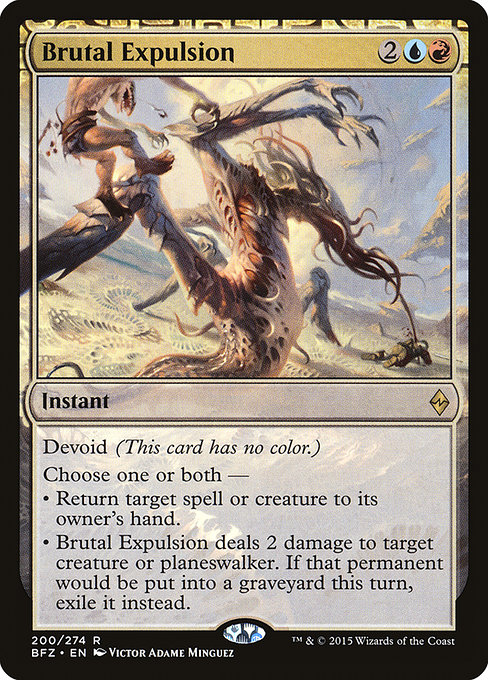
Image courtesy of Scryfall.com
Brutal Expulsion and the Shape of Fan Card Design
In the sprawling, ever-adaptable sandbox of MTG, Brutal Expulsion stands as a brilliant case study for fans who want to translate a card’s feel into their own creative designs. Released in Battle for Zendikar, this rare instant costs 2 colorless mana, plus blue and red, and carries the enigmatic Devoid trait—a reminder that the spell’s identity isn’t bound by a color, even though the mana cost pays homage to blue and red. That Devoid flavor is more than a gimmick; it signals to fans and designers alike that colorless magic can carry real bite and strategic texture, and it invites designers to experiment with nontraditional identities in their fan-made cards. 🧙♂️🔥
The card’s text—“Choose one or both — Return target spell or creature to its owner's hand. Brutal Expulsion deals 2 damage to target creature or planeswalker. If that creature or planeswalker would die this turn, exile it instead.”—turns a tempo swing into a multi-tool. It skews toward a world where death is not always the final boss, and where a clever player can pressure the board while keeping a stubborn threat from re-entering the fray. The two options aren’t simply additive; they interact in meaningful ways with the meta. If you bounce a creature, you slow an opposing plan; if you ping a planeswalker, you shrink its loyalty, buying you crucial turns. And the exile clause adds a safety valve against recursion or protective layers that players lean on late game. This dual-mode design is a perfect blueprint for fans who want their own colorless or “devoid-flavored” spells that demand precise timing and thoughtful sequencing. 🎨⚔️
For fan creators, Brutal Expulsion becomes a springboard into modal design experiments. The lack of a color identity in the spell text invites exploring other colorless or skewed identities—cards that feel like they could exist outside the color wheel but still speak their own language. When you design a fan card inspired by Expulsion, you can lean into its identity-by-choice frame: give players two or more distinct modes, each with its own tactical veneer (removal, tempo, tempo-neutralizing effects, or even protection-style outcomes). The key is to preserve clarity while letting the card’s power feel tailor-made for a particular deck archetype. This is where nostalgia and novelty meet: a fan card can honor the original’s spirit while pushing into new mechanical neighborhoods. 🧙♂️💎
Design takeaways that translate well to fan-made creatures and spells
- Modal power with purpose: Give players meaningful choices that can alter the board state without overloading the card. The bounce option creates tempo plays; the damage/exile option creates removal pressure and protection against recurring threats. Fans can translate this model into colorless or hybrid spells that feel crucial in limited and constructed alike. 🔥
- Colorless identity can carry colorful flavor: Devoid shows how a colorless spell can have character, even with a visually “colorless” palette. Fan designers can lean into flavor words and art direction that hint at a noncolor identity, then back it up with crisp mechanical decisions. 🎨
- Death isn’t always permanent: The exile-if-it-would-die clause is a modern take on “removal with a twist.” Designing fan cards around similar lifecycles—bounce, exile, or recover—can lead to a robust suite of spells that feel fresh yet familiar. 🧙♂️
- Rhythms of tempo and board state: Expulsion rewards careful timing. Fan cards that reward or punish tempo swings create a living, breathing drafting and play experience—something players crave when they tinker with home-brew sets. ⚔️
- Clear text, bold intent: When you translate this design into fan art or fan-crafted cards, clarity wins. Each option should be immediately understandable, with a clean balance of risk and reward so that players can read the card once and know exactly what to plan for. 🧩
In the broader conversation about fan design culture—where builders borrow from and remix classic MTG ideas—Brutal Expulsion demonstrates how a single card can ripple outward. The block’s Eldrazi-inflected flavor—where vast, colorless forces collide with human-scale tactics—echoes in fan-made cards that favor modular, adaptable effects over rigid, color-bound power curves. It’s no accident that the Battle for Zendikar era remains a touchstone for modern deck-building experimentation and for players who sketch up new creatures and spells at the kitchen table, then test them against the internet’s living metagame. 🧭🧙♂️
From table to table: fan cards in the wild
When fans craft a creature card inspired by Brutal Expulsion, they often emphasize resilience and resilience through control—creating a creature that can stall, bounce, or pivot the battlefield in a handful of turns. For instance, consider a fan design that mirrors the two-pronged spirit of Expulsion but shifts into a creature-focused arena: a colorless or colorless-leaning creature with a mode to tap to bounce an opponent’s spell or to deal a small amount of damage to a foe, optionally flashing into exile-like removal for a temporary answer. The appeal is in flexibility and storytelling—two constants fans crave when creating their own MTG universes. 🧙♂️🎲
Clear Silicone Phone Case: Slim & Flexible with Open Ports